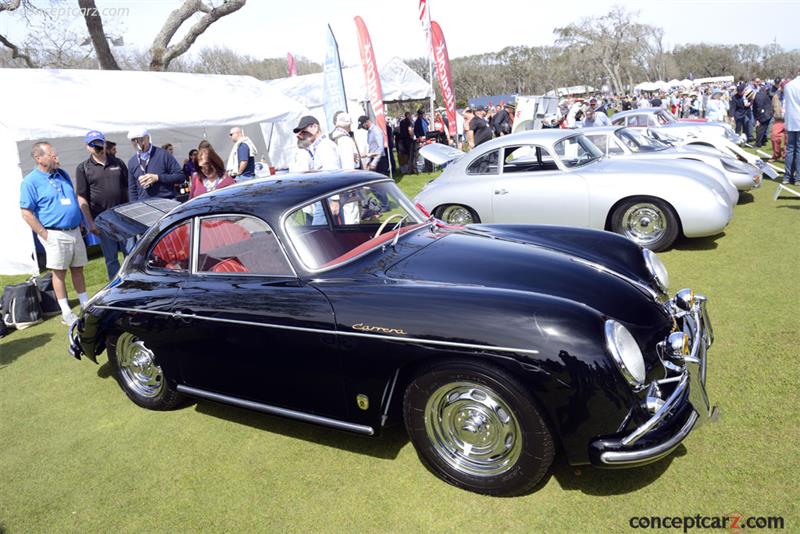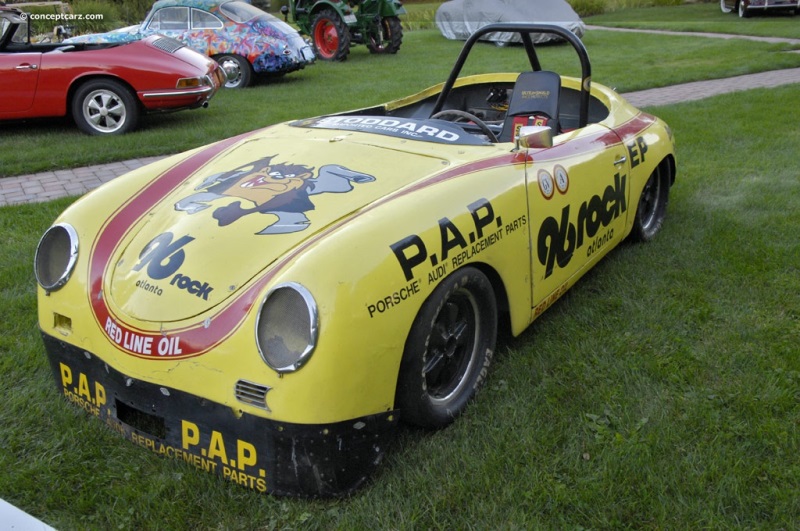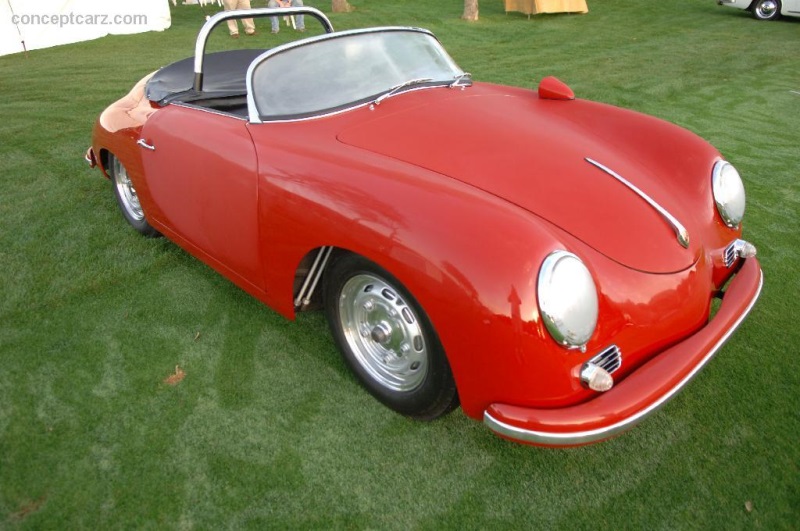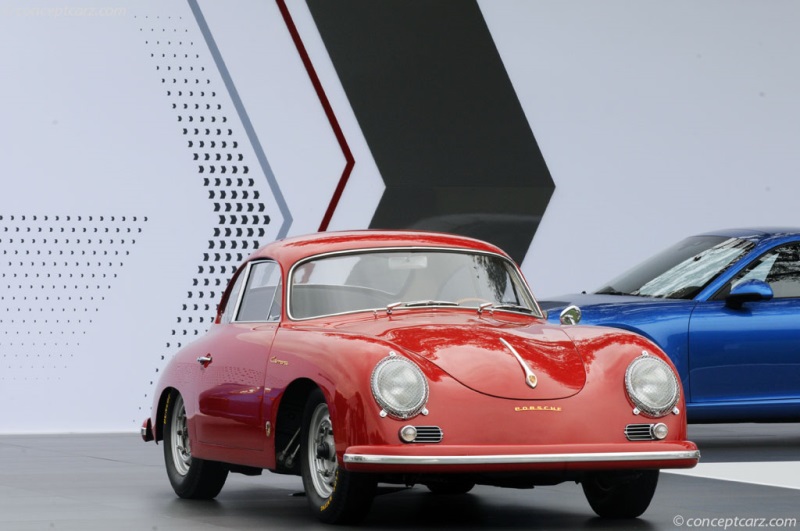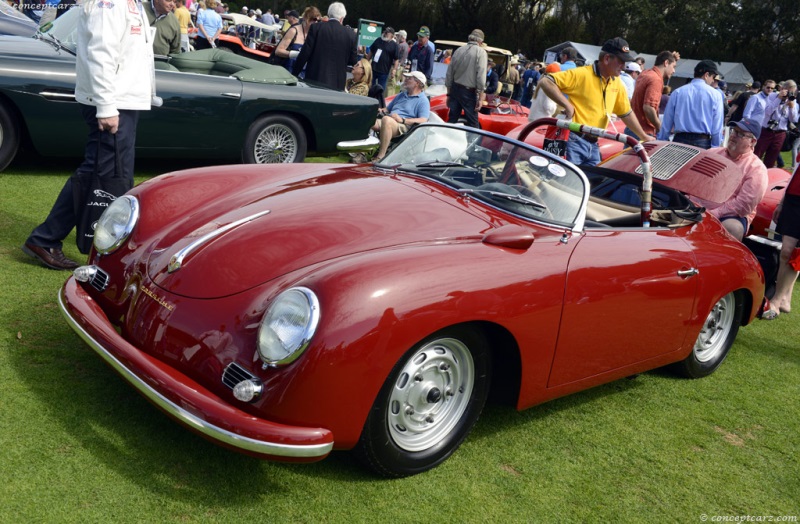History
During the war, Ferdinand 'Ferry' Porsche and a handful of his proven, faithful employees had started work on development number 356 in their workshops moved to the town of Gmünd in Karnten. The first design drawings were completed on 17 July 1947, and on 8 June 1948, the Karnten state government issued a special permit homologating the car. Returning home after being held by the French as a prisoner of war and bailed out of custody by his family, Professor Dr.-Ing.h.c.Ferdinand Porsche, Ferry's father, stated right away that 'every single bolt was just right'. No 1 was then followed by a small series of 52 additional cars built in Gmünd, production in Stuttgart from 1950 - 1965 subsequently amounting to 78,000 units of the 356 model Porsche No 1, a mid-engined roadster, is completed and homologated in the Austrian town of Gmünd. The engine displaces 1131 cc and develops maximum output of 35 bhp(26 kW). The first few 356 coupes are made of light alloy.
The Porsche 1500 S ('Super') was launched in 1952 and was capable of producing 70 bhp.
In 1953, the Porsche 1300 S producing 60 horsepower, was added to the Porsche line-up. This was also the year the Porsche was introduced to the United States. The split windshields are also replaced by bent windshields during this year.
1954 marked the production of the first 200 Porsche Speedsters.
In 1955, the Speedster became a genuine sales success. Production of the 356 A series starts in autumn with the proven 1300 and 1300 S power units soon joined by the 1600(1582 cc, 60 bhp/44 kW), 1600 S (1582 cc, 75 bhp/55 kW) and 1500 GS -the first Carrera marking the introduction of the new sports engine with four overhead camshafts - (1498 cc, 100 bhp/74 kW). The 1100-ccengines are dropped from the range.
During the 1956 model year, Porsche produces its 10,000th 356 model.
In 1957, the sporting and Spartan Porsche 1500 GS Carrera was joined by the more comfortable 1500GS de Luxe model.
In 1958, output of the Porsche 356 A 1500 GS Carrera GT is boosted to 110 bhp/81 kW. The Speedster is replaced by the Convertible D with a larger windscreen and winding windows at the side. The 1300-cc engines are dropped from the range.
In 1959, the Carrera received extra power and is now called the 1600 GS-GT, with the sports version offering more output (1588 cc, 115 bhp/85 kW) than the de Luxe model (105 bhp/77 kW). The 356 B series is introduced in autumn, the Convertible D being renamed the Roadster.Source - Porsche
The Porsche 1500 S ('Super') was launched in 1952 and was capable of producing 70 bhp.
In 1953, the Porsche 1300 S producing 60 horsepower, was added to the Porsche line-up. This was also the year the Porsche was introduced to the United States. The split windshields are also replaced by bent windshields during this year.
1954 marked the production of the first 200 Porsche Speedsters.
In 1955, the Speedster became a genuine sales success. Production of the 356 A series starts in autumn with the proven 1300 and 1300 S power units soon joined by the 1600(1582 cc, 60 bhp/44 kW), 1600 S (1582 cc, 75 bhp/55 kW) and 1500 GS -the first Carrera marking the introduction of the new sports engine with four overhead camshafts - (1498 cc, 100 bhp/74 kW). The 1100-ccengines are dropped from the range.
During the 1956 model year, Porsche produces its 10,000th 356 model.
In 1957, the sporting and Spartan Porsche 1500 GS Carrera was joined by the more comfortable 1500GS de Luxe model.
In 1958, output of the Porsche 356 A 1500 GS Carrera GT is boosted to 110 bhp/81 kW. The Speedster is replaced by the Convertible D with a larger windscreen and winding windows at the side. The 1300-cc engines are dropped from the range.
In 1959, the Carrera received extra power and is now called the 1600 GS-GT, with the sports version offering more output (1588 cc, 115 bhp/85 kW) than the de Luxe model (105 bhp/77 kW). The 356 B series is introduced in autumn, the Convertible D being renamed the Roadster.Source - Porsche
The Porsche 365C has been named the number ten on the list of Top Sports Cars of the 1960s by Sports Car International in 2004. The Porsche 356 is still widely regarded as a collector car that has capably stood the test of time.
There is some debate over which vehicle was the first official Porsche, the pre-war Porsche 64 being actually a VW racing automobile. The 356 was a sports car designed by Porsche that sold from 1948 through 1964 and was Porsche's first production automobile. A prototype for the 356, the 'Number 1' had a mid-engine. The name for the 356 was chosen as it was the 356th project off the Porsche design desk. In 1949, production officially began in Stuttgart, Germany.
Designed and fabricated by Ferdinand 'Ferry' Porsche (the son of well-known Dr. Ing Ferdinand Porsche, founder of Porsche motors), the Project # 356 concept was then styled by Irwin Komenda. Bailed out of custody by his family, Professor Dr.-Ing.h.c.Ferdinand Porsche was a held as a prisoner of war by the French. During the war, Ferry Porsche and a small handful of his faithful employees began work on the 356 in their workshops moved to the town of Gmünd in Karnten. On Dr. Porsche's return to his family, he stated right away that 'every single bolt was just right'.
On July 17th, 1947, the first design drawings were completed, and it was an entire year later when the Karnten state government issued a special permit homologating the car on June 8th, 1948.
Komenda, born in 1904 in Austria, was also responsible for contributing substantially to the construction of the Volkswagen, Cistalia, Auto Union racers, and other vehicles of the day. Joining Porsche's design bureau in 1931, Komenda held various positions at Steyr, Daimler-Benz and other coach shops in both Austria and Germany. He is responsible for contributing to a variety of other designs in Porsche's history, and was the chief engineer and head of Porsche's coachwork from 1955 until he died in 1966. The 'confidential clerk' for Porsche, Karl Peter-Rabe became the chief business manager, after Dr. Ing Albert Prizing, until 1965. Prizing was a business manager who is famous for bringing 37 orders back to the factory following one importer's conference in Wolfsberg in 1950.
The prototype was taken various times by Ferry, variously with just the rolling chassis without body, up the steep mountain roads surrounding the city to test its agile handling and durability. Ferdinand Porsche went on to live a long life, and died on March 27th, at the age of 88. Contributing to the handling of the prototype was the gearbox and suspension specialist Karl Frolich.
Evolving through several updates through the years, the 365 was originally available as a coupe, a cabriolet and finally a roadster. The vehicle changed from mid-engine to rear, along with a myriad of details that evolved over the 22 year run of the model, though the recognizable shape of the vehicle remained the same, a timeless classic. The most desirable versions were the Porsche 356 Carrera, which came with a special racing engine, and the 'Super 90' and 'Speedster' models. The same price as a Cadillac at the time, the price of a late 1950's Porsche was nearly $4,000. Today, a 356 Carrera model can sell for well over $150,000.
The very first Porsche sport car was hand built in Gmünd/Karnten, Austria. The entire aluminum body was hand-beaten over a wooden buck. Without the benefits of a machine shop, all of the engine and drive-train components were made completely. Over 50 Gmünd cars were built and sold primarily in Austria and Germany. To be closer to parts suppliers, the Porsche Firm, located to Zuffenhausen, Austria, near the Reutter coachworks following the war. The only Porsche to ever have the engine mounted in front of the rear axle, the 356/1 was open top 2-seater. Designed with a tubular chassis, the vehicle was air-cooled and came with a 110 cc engine that was remarkably light and quick for the times. Following this first ever radical design, every Porsche 356 to follow was constructed with the engine in the rear, behind the axle.
The Reutter Company, located in Stuttgart Germany, was given the assignment in late 1949 to construct 500 body works for an adjusted model of the 356 unit. This classic 356 was capable of reaching a speed of 140 kph. Under the belief that selling more than 500 units was an impossible feat, it was a pleasant surprise on March 15, 1954, car no. 5,000 left the factory.
Over the years, the 356 was updated with various mechanical refinements, though the basic shape was retained and remained instantly recognizable from year to year. The final 356B Roadster was built in early 1963, while both Coupe and Cabriolet models continued to be built every year up until 1965.
With a top speed of over 85 mph (135kph), a total of only 4 models of the 356 were produced in 1948. The 356/1 came with a 1.1 liter engine that was capable of making 40 horsepower. Less than 60 units were produced during 1949 and the earlier part of 1950. These very rare and unique models are known today as the Gmünd Coupes. The tiny sport cars continued to be built during 1950, but now at a factory in Stuttgart where Porsche moved production. A total of 298 units were built and delivered to their owners by the end of 1950.
One year later, three engines, all of them were flat-4's 'boxers' that were air cooled and were available from the factory. They were available at the 1,100cc, the 1,300cc, and the 1,500cc. The 1500 Super was the top power-plant during late 1952, which came with a synchromesh transmission. That same year the America Roadster was designed and created. Only a total of sixteen models were produced, and all units were an aluminum cabriolet body that came with a removable windshield. In 1992, this vehicle inspired the 40th Anniversary 1992 911 America Roadster.
Under the advice of Max Hoffman, the sole importer of Porsches into the U.S., the 356 'Speedster' was introduced in late 1954. The idea was to produce a lower-cost vehicle that was a racier version that would appeal to the American market. Proving to be an instantaneous hit, the Speedster came with a low, raked windshield that was easily removed, bucket seats, and a minimal folding top. In 1954, the Speedster was available for $2,995. This unit was available in a variety of six different engine types, the 1100, 1300, 1300A, 1300S, 1500 and 1500S. The 1500Super was the top-of-the-line model, while the Coupe and Cabriolet wore the 'Continental' badge designation. In 1955 the 1600 motor went into production.
In 1956, the 356A was unveiled to the world, and had an all-steel body, curved windshield and smaller wheels. When the cars were introduced, numerous subtle differences in the shape of the body and features were highlighted. In 1956 the 10,000th 356 unit rolled off the assembly line. The 356 Carrera was introduced at the same time, which came with a 1500GS engine. Before being replaced in 1959 by the Convertible D model, the Speedster peaked at a total of 1,171 units produced. In this same year, the 1300 engine was dropped from the line. A new project was the result from continued improvements to the 356A, the Type 2 or 'T-2', now with a new transmission, the 644 replaced the earlier 519 with an improved shifter, better synchros, dual nose mounts and a split case design. A higher horsepower is achieved in 1958 as continuous improvements were made in the Carrera engines.
The D model featured more comfortable seating, along with a more practical windshield, and glass side windows. In an attempt to boost sinking sales, around 1300 of these models were produced. While previous models were developed by Reutter coachbuilders, the Convertible D model was developed by Drauz, which is what the 'D' stands for. The D model falls somewhere between a Speedster and a Cabriolet in both luxury and lightweight appointments. In the later months of 1959, the Convertible D became a roadster with the new T-5 body style. Today to the convertible D is considered very desirable, due to the low number of units produced.
In 1960 the 356B offered the S90, or 'Super 90' motor as an available option. The vehicle also had a counterweighted crank, sodium-filled valves and Solex P40-II carburetors. The Karmann Coachworks were employed in 1961 to produce the 'Hardtop', a Cabriolet body with a fixed hard roof. The nickname 'Notchback' was affixed to these cars because of their profile. Nearly 1750 of these vehicles were produced during the two years of its production.
It was one year later when the 356B was introduced, updated with an entirely new body and Super 90 engine. In 1962 and 1963, the engine was once again revised, and changed body styles. A very small number of 356B 4-seater coupes were produced by a Swiss company. Though rare, several models are still around today. Next was the introduction of the Carrera 2 in April of 1962, and only around 450 models were produced in both Coupe and Cabriolet form. In the same year, Karmann produced 2170 coupes, and Reutter produced 4100. The production for the year topped 7900 when the almost 1600 Cabriolets are added into the count. The discussion is broached by Porsche with Reutter to purchase the coachmaker, and finally, after 12-years of co-operation, the successes are consolidated. 'Christophorus', a customer magazine filled with news and background on the Porsche lifestyle is launched by the Porsche factory.
The 356C, the final model, known also as the Type 6 (T-6), was available in 1964 with an engine that came from the same lines as previous Spyder engines, the most powerful pushrod engine Porsche every produced, was cable of producing 130 horsepower. Offering the 1600C, 1600SC and Carrerra 2 engines, the 356C featured 4-wheel disc brakes. Both the C and SC were available for purchase in either Coupe or Cabriolet form.
In 1964, a total of 14,151 356 units were produced. Porsche had achieved a production rate higher in that year alone than the entire line production of the first 10 years of the Porsche 356. The 911 was introduced at this time, presaging the end of the 356 run. Through the end of 1965, the company continued to sell the 365C in North America as a lower-cost vehicle.
Achieving a victory in the 1100cc class during its first outing, the original 356-001 vehicle was raced at the Innsbruck city race. In Austria, on the 8th of June 1948, the Porsche was homologated by the state government of Karnten. Frequently touring the world for special car shows and historic events, the original Porsche '001' vehicle is in the Factory Museum.
Near the end of 1965, more than 76,000 Porsche 356 models were produced and sold. Following 17 years of production, the model 912 eventually took over the 356's stance in the market. The push-rod engine from the 356 was reused to power the 'entry level' 912 model that was produced from 1965 to 1969.
The Porsche '901' was introduced at the Frankfurt Motor Show in 1963. Later after a protest by Peugeot, the name was changed to '911'. In 1964 the Porsche 911 began production.By Jessica Donaldson
There is some debate over which vehicle was the first official Porsche, the pre-war Porsche 64 being actually a VW racing automobile. The 356 was a sports car designed by Porsche that sold from 1948 through 1964 and was Porsche's first production automobile. A prototype for the 356, the 'Number 1' had a mid-engine. The name for the 356 was chosen as it was the 356th project off the Porsche design desk. In 1949, production officially began in Stuttgart, Germany.
Designed and fabricated by Ferdinand 'Ferry' Porsche (the son of well-known Dr. Ing Ferdinand Porsche, founder of Porsche motors), the Project # 356 concept was then styled by Irwin Komenda. Bailed out of custody by his family, Professor Dr.-Ing.h.c.Ferdinand Porsche was a held as a prisoner of war by the French. During the war, Ferry Porsche and a small handful of his faithful employees began work on the 356 in their workshops moved to the town of Gmünd in Karnten. On Dr. Porsche's return to his family, he stated right away that 'every single bolt was just right'.
On July 17th, 1947, the first design drawings were completed, and it was an entire year later when the Karnten state government issued a special permit homologating the car on June 8th, 1948.
Komenda, born in 1904 in Austria, was also responsible for contributing substantially to the construction of the Volkswagen, Cistalia, Auto Union racers, and other vehicles of the day. Joining Porsche's design bureau in 1931, Komenda held various positions at Steyr, Daimler-Benz and other coach shops in both Austria and Germany. He is responsible for contributing to a variety of other designs in Porsche's history, and was the chief engineer and head of Porsche's coachwork from 1955 until he died in 1966. The 'confidential clerk' for Porsche, Karl Peter-Rabe became the chief business manager, after Dr. Ing Albert Prizing, until 1965. Prizing was a business manager who is famous for bringing 37 orders back to the factory following one importer's conference in Wolfsberg in 1950.
The prototype was taken various times by Ferry, variously with just the rolling chassis without body, up the steep mountain roads surrounding the city to test its agile handling and durability. Ferdinand Porsche went on to live a long life, and died on March 27th, at the age of 88. Contributing to the handling of the prototype was the gearbox and suspension specialist Karl Frolich.
Evolving through several updates through the years, the 365 was originally available as a coupe, a cabriolet and finally a roadster. The vehicle changed from mid-engine to rear, along with a myriad of details that evolved over the 22 year run of the model, though the recognizable shape of the vehicle remained the same, a timeless classic. The most desirable versions were the Porsche 356 Carrera, which came with a special racing engine, and the 'Super 90' and 'Speedster' models. The same price as a Cadillac at the time, the price of a late 1950's Porsche was nearly $4,000. Today, a 356 Carrera model can sell for well over $150,000.
The very first Porsche sport car was hand built in Gmünd/Karnten, Austria. The entire aluminum body was hand-beaten over a wooden buck. Without the benefits of a machine shop, all of the engine and drive-train components were made completely. Over 50 Gmünd cars were built and sold primarily in Austria and Germany. To be closer to parts suppliers, the Porsche Firm, located to Zuffenhausen, Austria, near the Reutter coachworks following the war. The only Porsche to ever have the engine mounted in front of the rear axle, the 356/1 was open top 2-seater. Designed with a tubular chassis, the vehicle was air-cooled and came with a 110 cc engine that was remarkably light and quick for the times. Following this first ever radical design, every Porsche 356 to follow was constructed with the engine in the rear, behind the axle.
The Reutter Company, located in Stuttgart Germany, was given the assignment in late 1949 to construct 500 body works for an adjusted model of the 356 unit. This classic 356 was capable of reaching a speed of 140 kph. Under the belief that selling more than 500 units was an impossible feat, it was a pleasant surprise on March 15, 1954, car no. 5,000 left the factory.
Over the years, the 356 was updated with various mechanical refinements, though the basic shape was retained and remained instantly recognizable from year to year. The final 356B Roadster was built in early 1963, while both Coupe and Cabriolet models continued to be built every year up until 1965.
With a top speed of over 85 mph (135kph), a total of only 4 models of the 356 were produced in 1948. The 356/1 came with a 1.1 liter engine that was capable of making 40 horsepower. Less than 60 units were produced during 1949 and the earlier part of 1950. These very rare and unique models are known today as the Gmünd Coupes. The tiny sport cars continued to be built during 1950, but now at a factory in Stuttgart where Porsche moved production. A total of 298 units were built and delivered to their owners by the end of 1950.
One year later, three engines, all of them were flat-4's 'boxers' that were air cooled and were available from the factory. They were available at the 1,100cc, the 1,300cc, and the 1,500cc. The 1500 Super was the top power-plant during late 1952, which came with a synchromesh transmission. That same year the America Roadster was designed and created. Only a total of sixteen models were produced, and all units were an aluminum cabriolet body that came with a removable windshield. In 1992, this vehicle inspired the 40th Anniversary 1992 911 America Roadster.
Under the advice of Max Hoffman, the sole importer of Porsches into the U.S., the 356 'Speedster' was introduced in late 1954. The idea was to produce a lower-cost vehicle that was a racier version that would appeal to the American market. Proving to be an instantaneous hit, the Speedster came with a low, raked windshield that was easily removed, bucket seats, and a minimal folding top. In 1954, the Speedster was available for $2,995. This unit was available in a variety of six different engine types, the 1100, 1300, 1300A, 1300S, 1500 and 1500S. The 1500Super was the top-of-the-line model, while the Coupe and Cabriolet wore the 'Continental' badge designation. In 1955 the 1600 motor went into production.
In 1956, the 356A was unveiled to the world, and had an all-steel body, curved windshield and smaller wheels. When the cars were introduced, numerous subtle differences in the shape of the body and features were highlighted. In 1956 the 10,000th 356 unit rolled off the assembly line. The 356 Carrera was introduced at the same time, which came with a 1500GS engine. Before being replaced in 1959 by the Convertible D model, the Speedster peaked at a total of 1,171 units produced. In this same year, the 1300 engine was dropped from the line. A new project was the result from continued improvements to the 356A, the Type 2 or 'T-2', now with a new transmission, the 644 replaced the earlier 519 with an improved shifter, better synchros, dual nose mounts and a split case design. A higher horsepower is achieved in 1958 as continuous improvements were made in the Carrera engines.
The D model featured more comfortable seating, along with a more practical windshield, and glass side windows. In an attempt to boost sinking sales, around 1300 of these models were produced. While previous models were developed by Reutter coachbuilders, the Convertible D model was developed by Drauz, which is what the 'D' stands for. The D model falls somewhere between a Speedster and a Cabriolet in both luxury and lightweight appointments. In the later months of 1959, the Convertible D became a roadster with the new T-5 body style. Today to the convertible D is considered very desirable, due to the low number of units produced.
In 1960 the 356B offered the S90, or 'Super 90' motor as an available option. The vehicle also had a counterweighted crank, sodium-filled valves and Solex P40-II carburetors. The Karmann Coachworks were employed in 1961 to produce the 'Hardtop', a Cabriolet body with a fixed hard roof. The nickname 'Notchback' was affixed to these cars because of their profile. Nearly 1750 of these vehicles were produced during the two years of its production.
It was one year later when the 356B was introduced, updated with an entirely new body and Super 90 engine. In 1962 and 1963, the engine was once again revised, and changed body styles. A very small number of 356B 4-seater coupes were produced by a Swiss company. Though rare, several models are still around today. Next was the introduction of the Carrera 2 in April of 1962, and only around 450 models were produced in both Coupe and Cabriolet form. In the same year, Karmann produced 2170 coupes, and Reutter produced 4100. The production for the year topped 7900 when the almost 1600 Cabriolets are added into the count. The discussion is broached by Porsche with Reutter to purchase the coachmaker, and finally, after 12-years of co-operation, the successes are consolidated. 'Christophorus', a customer magazine filled with news and background on the Porsche lifestyle is launched by the Porsche factory.
The 356C, the final model, known also as the Type 6 (T-6), was available in 1964 with an engine that came from the same lines as previous Spyder engines, the most powerful pushrod engine Porsche every produced, was cable of producing 130 horsepower. Offering the 1600C, 1600SC and Carrerra 2 engines, the 356C featured 4-wheel disc brakes. Both the C and SC were available for purchase in either Coupe or Cabriolet form.
In 1964, a total of 14,151 356 units were produced. Porsche had achieved a production rate higher in that year alone than the entire line production of the first 10 years of the Porsche 356. The 911 was introduced at this time, presaging the end of the 356 run. Through the end of 1965, the company continued to sell the 365C in North America as a lower-cost vehicle.
Achieving a victory in the 1100cc class during its first outing, the original 356-001 vehicle was raced at the Innsbruck city race. In Austria, on the 8th of June 1948, the Porsche was homologated by the state government of Karnten. Frequently touring the world for special car shows and historic events, the original Porsche '001' vehicle is in the Factory Museum.
Near the end of 1965, more than 76,000 Porsche 356 models were produced and sold. Following 17 years of production, the model 912 eventually took over the 356's stance in the market. The push-rod engine from the 356 was reused to power the 'entry level' 912 model that was produced from 1965 to 1969.
The Porsche '901' was introduced at the Frankfurt Motor Show in 1963. Later after a protest by Peugeot, the name was changed to '911'. In 1964 the Porsche 911 began production.By Jessica Donaldson
Similar Automakers
Similarly Sized Vehicles
from 1959
Similarly Priced Vehicles
1959 Porsche 356A Carrera GS/GT Vehicle Profiles
Recent Vehicle Additions
Performance and Specification Comparison
Price Comparison
$3,580 - $5,900
356 Carrera 1500 GS / GT Specification Comparison by Year
Year
Production
Wheelbase
Engine
Prices
82.70 in.
4 cyl., 96.54 CID., 74.00hp
4 cyl., 96.85 CID., 113.00hp
4 cyl., 122.05 CID., 135.00hp
4 cyl., 96.85 CID., 113.00hp
4 cyl., 122.05 CID., 135.00hp
$5,660 - $5,920
Related Automotive News

'Hidden Treasure' Porsche Icon at Bonhams Amelia Island Auction
550 SPYDER WITH PERIOD RACE HISTORY OFFERED FOR FIRST TIME IN 50 YEARS
One of the most important Porsche models ever produced will headline Bonhams Amelia Island Sale on March 3 in Florida, being offered after 50 years of ownership and displayed...

Gooding & Company to Offer the Most Exceptional Selection of Porsche Spyders at the Company's 15th Annual Pebble Beach Auctions
The first appearance of an RS Spyder at public auction highlights this impressive offering of Porsche Spyders
Santa Monica, Calif. (July 25, 2018) – Gooding %26 Company, the official auction house of the Pebble Beach Concours dElegance®,...

Ferrari 365GTB/4 Daytona at Amelia Island Concours
Its been a half-century since Pininfarina created the timeless shape of the Ferrari 365 GTB4. On March 11, 2018 that happy anniversary will be celebrated at the 23rd annual Amelia Island Concours dElegance with a special class of the rare and significant...

CHUBB INSURANCE CONCOURS D'ELÉGANCE AT SALON PRIVÉ CONFIRMS WORLD-LEADING COLLECTION OF CARS FOR 2015 EVENT
Outstanding line-up of cars will be paraded at new home of Blenheim Palace as Salon Privé celebrates 10th year anniversary
1937 Delahaye known as Star of India set to be one of the stars of the show, as well as Ferrari 250 GT Berlinetta Tour de...

BONHAMS TO OFFER FOR SALE BY AUCTION SIR STIRLING MOSS's 1961 PORSCHE RS-61 SPORTS-RACING CAR
The Bonhams Motor Car Department is delighted to announce that it has been commissioned to offer one of the greatest and most charismatic of all small-capacity sports-racing cars – Porsche RS-61 chassis number 718-070 – at the companys Goodwood Festival...

























